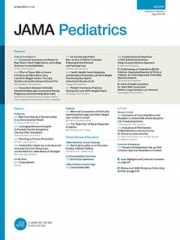Posted on October 06, 2014
Source: JAMA Pediatrics

Influence of age at virologic control on peripheral blood human immunodeficiency virus reservoir size and serostatus in perinatally infected adolescents
Persaud D, Patel K, Karalius B, Rainwater-Lovett K, Ziemniak C, Ellis A, Chen YH, Richman D, Siberry GK, Van Dyke RB, Burchett S, Seage GR 3rd, Luzuriaga K; Pediatric HIV/AIDS Cohort Study
IMPORTANCE:
Combination antiretroviral therapy initiated within several weeks of human immunodeficiency virus (HIV) infection in adults limits proviral reservoirs that preclude HIV cure. Biomarkers of restricted proviral reservoirs may aid in the monitoring of HIV remission or cure.
OBJECTIVES:
To quantify peripheral blood proviral reservoir size in perinatally HIV-infected (PHIV+) adolescents and to identify correlates of limited proviral reservoirs.
DESIGN, SETTING, AND PARTICIPANTS:
A cross-sectional study including 144 PHIV+ youths (median age, 14.3 years) enrolled in the United States-based Pediatric HIV/AIDS Cohort Study and receiving durable (median duration, 10.2 years) combination antiretroviral therapy, stratified by age at virologic control.
MAIN OUTCOMES AND MEASURES:
The primary end point was peripheral blood mononuclear cell (PBMC) proviral load after virologic control at different ages. Correlations between proviral load and markers of active HIV production (ie, HIV-specific antibodies, 2-long terminal repeat circles) and markers of immune activation and inflammation were also assessed.
RESULTS:
Proviral reservoir size was markedly reduced in the PHIV+ youth who achieved virologic control before 1 year of age (4.2 [interquartile range, 2.6-8.6] copies per 1 million PBMCs) compared with those who achieved virologic control at 1 to 5 years of age (19.4 [interquartile range, 5.5-99.8] copies per 1 million PBMCs) or after 5 years of age (70.7 [interquartile range, 23.2-209.4] copies per 1 million PBMCs; P < .001). A proviral burden of less than 10 copies per 1 million PBMCs in PHIV+ youth was measured in 11 (79%), 20 (40%), and 13 (18%) participants with virologic control before 1 year, at 1 to 5 years, and after 5 years of age, respectively (P < .001). Lower proviral load was associated with undetectable 2-long terminal repeat circles (P < .001) and HIV-negative or indeterminate serostatus (P < .001) but not with concentrations of soluble immune activation markers CD14 and CD163.
CONCLUSIONS AND RELEVANCE:
Early effective combination antiretroviral therapy with prolonged virologic suppression after perinatal HIV infection leads to negligible peripheral blood proviral reservoirs in adolescence and is associated with negative or indeterminate HIV serostatus. These findings highlight the long-term effect of early effective control of HIV replication on biomarkers of HIV persistence in perinatal infection and the utility of HIV serostatus as a biomarker for small proviral reservoir size, although not necessarily for cure.